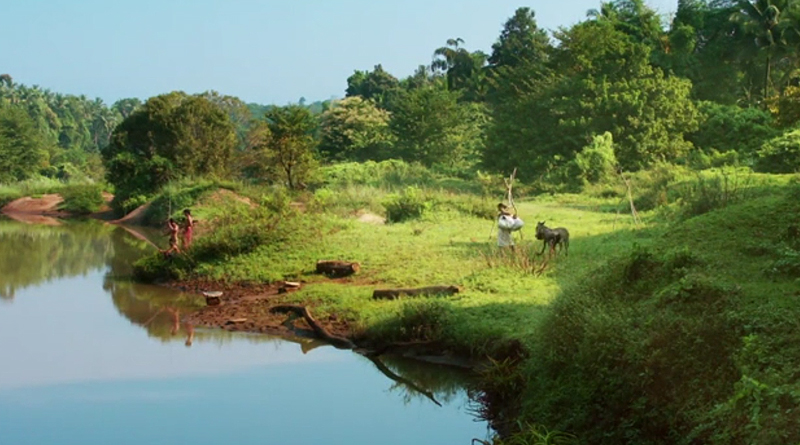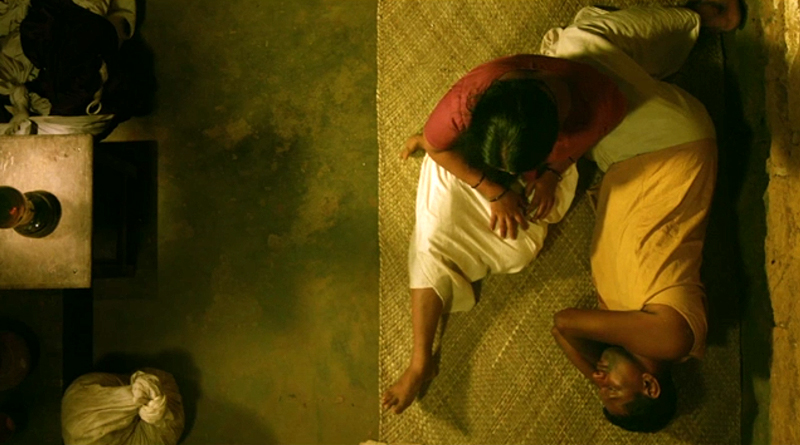Kharam

Kharam
Directed by PV Jose | Review byPrarthana Mitra
Indian regional cinema has a special gallery of filmmakers who untiringly hold a mirror to its grassroots movements and the socio-political landscapes that shape them. One such figure is P V Jose whose debut feature Kharam stays with you long after it is over, at a time when farmers’ and land rights agitation has gripped rural belts around the country. Running for the better part of two hours, the film presents a kaleidoscopic view into the lives, trials and tribulations of fringe-dwellers in rural Kerala, with a richness that escapes most activist-filmmakers. That is not to say that Kharam deals only with the macrocosmic issues that have plagued underprivileged communities for centuries. Rooted to the land and its people, the film merely utilises the social, economic and political vacuum to suggest that domestic problems at home often originate from these larger issues. In the process, however, it charts the evolution of underground activism in villages—far away from the tech-fuelled social media movements—where a grassroots rebellion rises from despair and dissatisfaction.

Jose’s characters skirt through verdant Kerala, the most literate state in the country and one of the last bastions of Communism; yet they suffer—like any other—under the yoke of patriarchy, poverty, injustice, neo-colonialism and feudalism. Protagonists Kanavan, Kanakki and Podiyan, an unlikely family of three, eke their existence at the mercy of the landowners, while their neighbour Murali, a tailor by profession but a man of lofty ideals, takes it upon himself to lead the charge against oppression of farmers. The first half deals with the developing relationship between the innocent Kannaki, who arrives at Kanavan’s household as his new wife, and a precocious Podiyan who still misses his mother dearly. The two protect each other from Kanavan’s drunken stupor and abuse, but in his habitual drinking and gambling problems, we get a glimpse of the disillusionment and frustration present in the working class. In fact, the toddy shop exemplifies the mentality of folks so used to oppression that they hardly know it when they inflict it back at home. The spectre of Podiyan’s biological mother who was brutally raped and left for dead by the river—whose portrait looms in the small thatched hut now shared by Kanavan and Kannaki—serves as reminder for its viewers of the ominous forces lurking both within and without. Constantly objectified and treated as Kanavan’s “property”, Kannaki feels reassured about her identity only around Murali. After learning of the death of Kanavan’s first wife, she is compelled to take extreme measures to protect herself from oppressive forces all around.

In the film, Jose’s years of having grown up in a village and worked closely with the people in it reflect strongly, enriching the fiction with reality. Travelling communist theatre juxtapose the rebels meeting covertly; a group of boys fish in the pond as Kannaki washes clothes at the dhobi ghat; the idiot boy’s superstitious belief that riding a donkey is the road to his cure—all these elements shed light on the various strands of life in Kharam. The cinematography by Raj Kumar B is quite evocative, and consistent for both outdoor and indoor shots. Most of it is static and long, and the colourscape suits the mood of the film. The scenes at night, especially, stand out for their impeccable lighting, where the interplay of silhouettes and shadows tell their own story. The natural beauty of wide open fields and sparsely populated villages nestled in an idyllic landscape, makes the job of capturing it infinitely easier.

The opening shot itself, where Kannaki follows Kanavan into the village for the very first time, is a master class in colour grading, natural light and camera angle— set to the tune of a Malayalam folk song by Viswajith C T. However, the background score for the rest of film had room for improvement. Only the sentimental flute fit in the context. The performances of Santhosh Keezhattoor as Murali, Praveena Madhavan as Kannaki and child artiste Sreedhil Madhav P R as Podiyan were par excellence, although their delivery could have been more effective with a sharper edit. Tightening the screenplay in the beginning could have perhaps built a better momentum. But for a debutante director, honesty and simplicity are the most crucial prerequisites, and Jose hits the nail on the head on both counts.
 Prarthana is presently in between odd jobs and obtaining her master’s degree in literature. She loves modern poetry and meditative cinema. Based out of Calcutta, Prarthana observes people, football, films and enjoys writing about all three. Of late, she relates to Frank Ocean’s music. Her writing experience consists of writing for various sites such as Try Cinema, The Indian Economist, Doing The Rondo, Saintbrush and various academic journals.
Prarthana is presently in between odd jobs and obtaining her master’s degree in literature. She loves modern poetry and meditative cinema. Based out of Calcutta, Prarthana observes people, football, films and enjoys writing about all three. Of late, she relates to Frank Ocean’s music. Her writing experience consists of writing for various sites such as Try Cinema, The Indian Economist, Doing The Rondo, Saintbrush and various academic journals.


